| Organic Seeds | Edible Plants | Organic Pest Controls | Books | Tools, Propagation & Fertilisers | Sprouting & Microgreens | Poultry Supplies | Specials & Gift Ideas |

Top

We will send an email to this address*
when is next available
* we will use this email address only for this notification and then we will delete it.
 Home
Home
Green Harvest Organic Gardening Supplies is permanently closed as of 5pm on 1-11-2023.
We will not be taking orders by this website, in person, by phone or email. Our display garden and retail shop are closed forever.
Read more...
Phone:07 54357000
Phone calls will only be responded to sporadically and only in reference to orders placed prior to 2-11-2023. All the useful growing and organic pest management research and resources are available on this website for a while still.
Keeping Food Production Going During Hot Humid Summers
Green Harvest carries a range of seeds ideally suited to hot, humid areas. To make finding them easier on the website below is a list with short description and hyperlink to other cultivars.
Gardeners in subtropical and tropical areas face a range of challenges in the vegetable garden during the 'wet'. Pests and weeds can spread in the blink of an eye, with fruit fly and fungal problems being particularly difficult to deal with.
One way of dealing with this season is to 'put the garden to bed', by spreading a liberal amount of mulch and refraining from sowing seeds until the weather starts to cool down in March. This doesn't mean there is nothing to harvest, only that the harvest is limited to perennial, tropical edibles such as asparagus, arrowroot, bamboo, cassava, chillies, choko, ginger, kangkong, lotus, pawpaw, pigeon pea, sweetleaf, sweet potato, taro, waterchestnuts and yam. Many of these plants are available seasonally. Find some of them here.
Alternatively you can substitute more familiar vegetables with hardier ones that are native to tropical regions and will withstand waterlogging and high humidity without collapsing in a slimey heap. Angled luffa or New Guinea bean will substitute for zucchini without the powdery mildew problems, snake bean will continue to set pods during very hot weather and is resistant to bean fly. Ceylon or Egyptian spinach are both rust resistant and won't bolt too fast as the weather warms up.
|
The following plants suitable for warmer climates are available seasonally as tubestock:
Betel Leaf, Brazilian Spinach, Ceylon Spinach, Cranberry Hibiscus, Kangkong, Okinawa Spinach, Peruvian Parsnip, Surinam Spinach and Tahitian Spinach. |
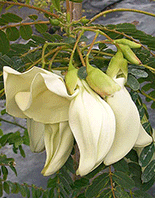 Agati
H
Agati
H
 UT
UTSesbania grandiflora Syn. vegetable hummingbird, agathi, West Indian pea Agati is a fast growing, tropical legume tree to 10 m high with beautiful, large white flowers. It does best in warm humid areas and will not tolerate temperatures below 10°C or frost. It is useful as a shade or nurse tree for other crops, such as black pepper. The leaves can be cut as animal (ruminant) fodder but avoid cutting the main stem. The young leaves, flowers and tender pods contain 25-30% crude protein and are favourite Asian vegetables. Remove the centre of the flowers before eating to reduce bitterness. Suitable for subtropical and tropical areas; unsuitable for temperate areas. More growing information... SA101 (approx. 14 seeds per pkt.) Agati plants are available seasonally. |
|
Amaranth Leaf
H
syn. Leaf Amaranth; Chinese Spinach, Tampala, bayam
Amaranthus tricolor A nutritious, leafy green for warmer areas. It is a fast-growing and best to harvest the whole plant as older plants get tough and bitter tasting. Successive sowings will provide greens over a long period. The leaves have a sweet, tangy flavour and are best cooked, raw leaves should not be eaten very often, as they are high in nitrates and oxalic acid. In China and Japan it is the main vegetable used as a cooked green. Leaf Amaranth prefers a fertile, well-drained garden soil, full sun to partial shade. Soil temperature needs to be at least 20°C to germinate seed, sow late spring and summer. Harvest is 30 days to baby leaf and 50 days to maturity, when they are about 20 cm tall. As they get older the leaves will get tougher. |
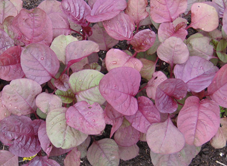 Amaranth 'Red'
H
OG
Amaranth 'Red'
H
OG'Red' is a very attractive, nutritious, red leafy green for warmer areas. SA124 (approx. 250 seeds per pkt.) SA125 |
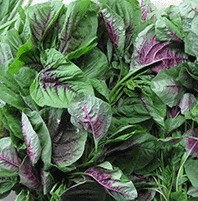 Amaranth 'Red Calaloo'
H
UT
Amaranth 'Red Calaloo'
H
UTSyn. Red Stripe Leaf Red Calaloo has attractive green leaves with a red splash down the middle. SA112 (approx. 250 seeds per pkt.) SA113 SA149 SA107 |
|
Angled Luffa
H
 syn. Okra Vine, Okra Cee Gwa
syn. Okra Vine, Okra Cee GwaLuffa acutangula Angled Luffa is a fast growing, vigorous annual vine that requires a trellis to grow on. The young fruits are similar in flavour to zucchini but slightly sweeter, it is a good substitute for zucchini in humid areas as it does not suffer fungal problems. The stem tops, young leaves and flower buds can be steamed as vegetables and the seeds from mature fruit roasted with salt and eaten. Plant it in a rich soil in full sun. Sow seed in spring. See also Luffa - Loofah |
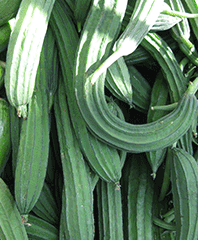
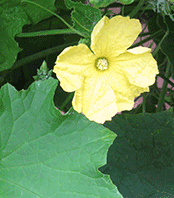 Angled Luffa
H
Angled Luffa
H
 UT
UTSA109 (approx. 12 seeds per pkt.) SA110 |
 Bean 'Poor Man's'
Rare
H
Bean 'Poor Man's'
Rare
H
 UT
UTLablab purpureus syn. Dolichos lablab syn. Tongan Bean, Bonavist pea, Indian bean, bataw Poor Man's Bean is an old Australian heirloom and was once found on many backyard fences in QLD. It is not forage lablab, which has much coarser pods. The deep pink flowers are followed by pale green pods, resembling snow peas in shape when young. It is a short-lived perennial and will live for 2 - 3 years. It is hardy and good at coping with wet, humid conditions. It is grown for its young, tender pods, edible leaves and flowers and is a popular vegetable in South East Asian and African cooking. The mature pods and dried beans contain toxins so should be well-cooked with a change of cooking water. It climbs vigorously to 2 - 3 metres and requires a strong trellis. Wait for warm, humid weather before sowing; it needs a soil temperature of at least 25°C to germinate well. It tolerates a wide soil range but prefers fertile, well-drained soil. SB369 (approx. 10 seeds per pkt.) Find other bean varieties here. |
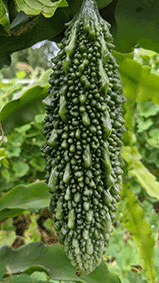 Bitter Melon
H syn. Fu kwa, Balsam Pear or Bitter Gourd
Bitter Melon
H syn. Fu kwa, Balsam Pear or Bitter GourdMomordica charantia A tropical climber with small, fragrant flowers produces a warty fruit. It produces prolifically but may need hand pollination in cool climates. Sow next to a trellis, after all danger of frost has passed, soil temperature min. 22ºC, 2.5 cm deep, 30 cm apart. Early plants can be sown in seedling pots for later transplanting. Prepare well-drained soil with compost and well-rotted manure. To avoid excessive bitterness, pick the green fruit when young. Fruit is peeled, rubbed with salt and left for an hour then rinsed and the central spongy pith discarded. Seeds should not be eaten. Alternatively it can be parboiled in salted water before use. Used as a cooked vegetable and in pickles and curries. Young leaves and shoots are edible. Days to harvest: 60 - 70. |
|
Melon - Bitter
H
UT A prolific, open-pollinated, traditional variety of bitter melon. The fruit are heavily warted and up to 25 - 30 cm long. Fruit are best picked when young and green. SM139 (approx. 8 seeds per pkt.) SM140 SM141 |
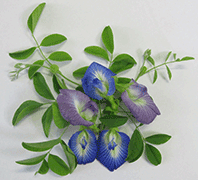 Butterfly Pea
H
Butterfly Pea
H
 UT
UTClitoria ternatea syn. Pigeonwings, Cordofan pea, Darwin pea A perennial climbing vine native to tropical Asia, with striking vivid blue flowers that besides being ornamental, are used to make a natural food colouring. It is in use throughout Asia to colour drinks, desserts and cakes. It can also be used as a natural dye for clothes. As a legume it is also grown for soil improvement. The pods are 5 cm long, flat pods are edible when tender. It is hardy and good at coping with wet, humid conditions. It climbs vigorously to and requires a trellis. Wait for warm, humid weather before sowing; it needs a soil temperature of at least 25°C to germinate well. It tolerates a wide soil range but prefers fertile, well-drained soil. SB448 (approx. 10 seeds per pkt.) SB467 |
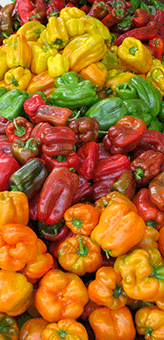 Growing Capsicum
Growing CapsicumCapsicum annuum Capsicums are warm season, frost tender annuals to 60 - 90 cm tall; generally staking them is a good idea. Seeds germinate best at 20 - 30°C soil temperature. Sowing at too low a temperature will cause delayed or failed germination. In Temperate Areas: sow in early spring - either inside with extra bottom heat by using a bottom heat propagator; behind a sunny window or on top of a hot water system; if sowing outside wait until all frost danger has passed and the soil is warm. Generally if starting capsicum inside then sow seed 6 to 8 weeks before the last expected frost date in your area. By sowing early there will be time for a good crop to be produced before the first frost in winter In Subtropical Areas: sow March - October in frost-free areas; wait for spring in areas that receive frost In Tropical Areas: all year but avoid January - February above 32˚C can affect fruit set Soil Type: fertile, well drained, garden loam with a pH of 5.5 - 7.0; prepare the soil by adding compost. If stakes are required then put them at the same time as transplanting takes place to avoid later root disturbance. Providing support to keep fruit clear of the ground helps keep fruit clean and prevents slug and snail damage. Germination period: 10 - 21 days (longer if the soil is cool); liquid feed the seedlings once germinated Planting depth: 6 mm deep Position: full sun Sow Where: into seedling pots to reduce transplant shock; transplant when the soil is warm Plant Spacing: 40 - 50 cm between plants; 60 - 90 cm apart between rows Details: keep well fertilised and watered; avoid high nitrogen fertilisers as these will promote leaf growth at the expense of fruit. In fruit fly areas the fruit should be protected by bagging Harvest: 16 - 20 weeks: pick early fruit green to encourage fruiting |
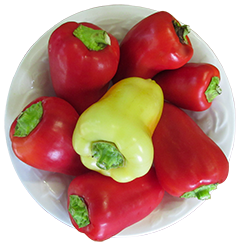 Capsicum 'Antohi Romanian'
H
UT
Capsicum 'Antohi Romanian'
H
UTA Romanian heirloom capsicum that is extremely prolific with an early harvest, so great for cooler areas, it does well in hot, humid areas too. The fruit starts off a pale lemon yellow, turns a pretty orange and ripens to red. The thick flesh and sweet flavour are enhanced by cooking. The fruit is smooth and tapered and held on upright plants with strong branches. Days to harvest: 78. SC153 (approx. 25 seeds per pkt.) SC584 Grower needed... |
 Capsicum 'California Wonder'
H
UT
Capsicum 'California Wonder'
H
UT'California Wonder' is a heavy producer of bell-shaped sweet capsicums; the fruit is thick-walled with a crisp, mild flavour. The fruit can be picked green or red. It is nutritious, high in Vitamin C and ideal for stuffing and salads. Days to harvest: 75. SC583 (approx. 35 seeds per pkt.) SC560 SC401 |
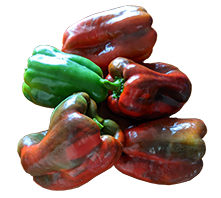 Capsicum 'Chinese Giant'
H
UT
Capsicum 'Chinese Giant'
H
UT'Chinese Giant' truly lives up to its name, producing the largest capsicums we have ever grown, 15 cm long by 10 cm wide. The large bell-shaped fruit ripen from green to ruby red. An open-pollinated heirloom variety from the USA, listed in 1902, that is very productive, disease-resistant and does well even in cooler climates. It is excellent for stuffing, salads and roasting. Days to harvest: 75. SC148 (approx. 25 seeds per pkt.) |
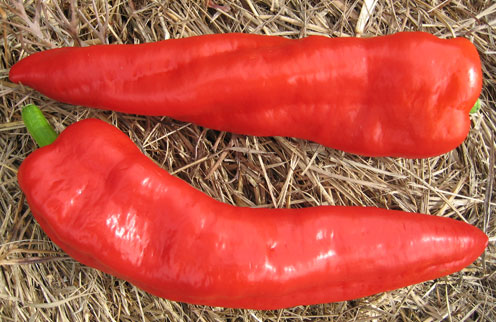 Capsicum 'Corno di Toro'
H
UT
Capsicum 'Corno di Toro'
H
UTSyn. 'Bull's Horn' An Italian heirloom sweet capsicum that produces curved, tapering fruits, 15 - 25 cm long, with a great, fruity flavour. When ripe they turn a stunning red or yellow. It is an excellent producer even in cool areas and easy to grow. Days to harvest: 72 - 85. SC409 (approx. 25 seeds per pkt.) |
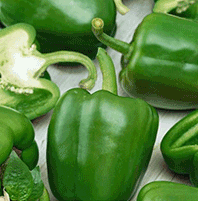 Capsicum 'Emerald Giant'
H
UT
Capsicum 'Emerald Giant'
H
UTSyn. 'Green Giant' 'Emerald Giant' was introduced in 1963 in the USA. It produces heavy yields of big, thick-walled and very sweet fruit. Fruit is a 3 to 4 lobed large bell-shape to 11 x 9 cm in size. The plants are tall, reaching a metre, sturdy and vigorous. The deep green fruit turn red when fully ripe but flavour is best at the green stage. It is good eaten fresh in salads or stuffed. Days to harvest: 78. SC648 (approx. 25 seeds per pkt.) |
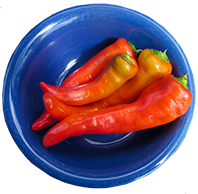 Capsicum 'Hungarian Sweet Paprika'
H
UT
Capsicum 'Hungarian Sweet Paprika'
H
UTSyn. Hungarian Stuffing Pepper 'Hungarian Sweet Paprika' is an heirloom variety of a type introduced by the Turks to Hungary in the 16th century. It is a prolific yielder of fleshy fruit up to 15 cm long that tapers from 5 cm wide to a blunt tip. The waxy skin turns from pale green to red when fully mature. The flavour is mild and sweet and becomes more complex as it ripens. Use it in salads, roasted, fried or pickled. It is one of the ingredients used to make paprika spice. It is early-maturing and very suitable for areas with a short growing season. Days to harvest: 58 - 75. SC639 (approx. 25 seeds per pkt.) |
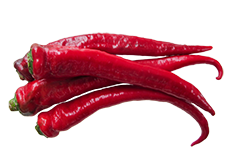 Capsicum 'Jimmy Nardello'
H
UT
Capsicum 'Jimmy Nardello'
H
UTA hardy and delicious heirloom capsicum originally from Italy, it looks chilli hot but instead is the sweetest capsicum we have tasted. The fruit can be picked green or ripened to a rich red. The fruit is long and thin-skinned and has a rich flavour. The bushes are prolific and it grows well in most areas. Worth trying in cooler areas where common bell capsicums fail. This variety has been placed in 'The Ark of Taste' by the Slow Food organisation. Days to harvest: 80 - 90. SC111 (approx. 25 seeds per pkt.) SC114 Grower needed... |
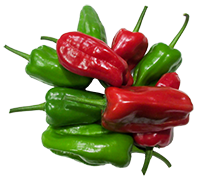 Capsicum 'Perennial'
H
UT
Capsicum 'Perennial'
H
UT'Perennial' is a tall, hardy, productive, bush capsicum that can live up to 5 years in the tropics. The fruit are 3 cm by 8 cm long and taper to a blunt point, ripening from green to red. It is resistant to wilt and can also be used as rootstock for grafting other capsicum varieties. Days to harvest: 70. SC384 (approx. 25 seeds per pkt.) SC471 SC399 SC300 Also available as tubestock Grower needed... |
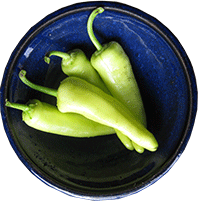 Capsicum 'Sweet Banana'
H
UT
Capsicum 'Sweet Banana'
H
UT'Sweet Banana' is an heirloom variety suitable for both cooler and tropical areas. It is very productive and crops early. Mild, yellow peppers turn brilliant red when fully ripe. Fruit is tapered, 17cm long, 3.5 cm wide. It looks like a chilli but is definitely not hot at all. This capsicum is a good for stir fries, salads or preserves. Days to harvest: 72. SC425 (approx. 25 seeds per pkt.) SC426 SC408 |
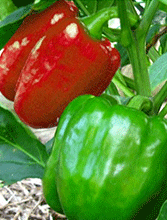 Capsicum 'Yolo Wonder'
H
UT
Capsicum 'Yolo Wonder'
H
UT'Yolo Wonder' is a heirloom variety introduced in 1952. It is a heavy yielder of large, thick-skinned fruit that turns from dark green to bright red when mature, with a mild sweet flavour. The fruit is big, four lobed blocky, 9-10 cm wide by 10-11 cm long. It is has dense foliage that protects the fruit from sunburn. SC637 (approx. 35 seeds per pkt.) SC638 SC407 |
|
Ceylon Spinach Basella spp Syn. Climbing Spinach, Malabar Spinach, Indian saag, espinaca basela, baselle, vine spinach. There are two varieties of this attractive, climbing leafy green, rich in vitamins A and C, iron and calcium. It can be eaten raw in salads or lightly cooked in stir-fries. It has a flavour similar to spinach. The older leaves develop a 'slipperiness', this mucilaginous property has been used traditionally as a thickening agent for soups and stews. It is perennial in the tropics and is native to tropical Asia. It can be grown as a warm season annual in cooler areas. Strangely enough, records show it was being cultivated in gardens in Scotland in 1689. It is useful over summer as it copes much better with heat than ordinary spinach. It likes to grow in full sun. We find it works well on a tripod trellis and it looks good in a hanging basket. |
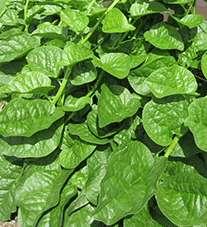 Ceylon Spinach - Green Stem
H
UT
Ceylon Spinach - Green Stem
H
UTBasella alba Syn. Climbing Spinach, Malabar Spinach. A green leaf - green stem version of this attractive climbing leafy green. Sow spring and summer. Does best in subtropical and tropical areas. SC217 (approx. 20 seeds per pkt.) SC289 SC142 Please note: Ceylon spinach has a known low germination of approx. 65%, similar to onions and parsnips. |
 Ceylon Spinach - Red Stem
H
UT
Ceylon Spinach - Red Stem
H
UTBasella alba 'Rubra' Syn. Climbing Spinach, Malabar Spinach. A green leaf - red stem version of this attractive climbing leafy green. Sow spring and summer. Does best in subtropical and tropical areas. SC726 (approx. 20 seeds per pkt.) SC727 SC122 Please note: Ceylon spinach has a known low germination of approx. 65%, similar to onions and parsnips. |
| Ceylon spinach plants are available from November to January. |
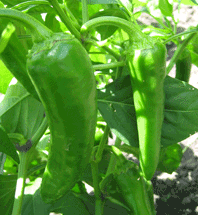 Growing Chilli
Growing ChilliCapsicum spp. Chillies are warm season, frost tender annuals to 60 - 80 cm tall. Seeds germinate best at 23 - 30°C soil temperature. Sowing at too low a temperature will cause delayed or failed germination. In Temperate Areas: sow in early spring - either inside with extra heat by using a bottom heat propagator; behind a sunny window or on top of a hot water system; if sowing outside wait until all frost danger has passed. In Subtropical Areas: sow March - October in frost-free areas; wait for spring in areas that receive frost In Tropical Areas: all year but avoid January - February Soil Type: fertile, well drained, garden loam with a pH of 5 - 6.0; prepare the soil by adding compost. Give moderate fertiliser and water throughout the growing season; avoid high nitrogen fertilisers as these will promote leaf growth at the expense of fruit. Germination period: 7 - 14 days (longer if the soil is cool); liquid feed the seedlings once germinated. Planting depth: 6 mm deep Position: full sun Sow Where: into seedling pots to reduce transplant shock; transplant when the soil is warm. Plant Spacing: 45 cm between plants Harvest: 10 weeks Scoville Scale The Scoville scale is a measure of the 'hotness' of a chilli pepper or anything made from chilli peppers, i.e. Tabasco sauce (2,500 - 5,000 Scoville). The scale is named after Wilbur Scoville who developed the test in 1912. |
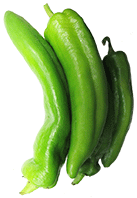 Chilli 'Anaheim'
H
UT
Chilli 'Anaheim'
H
UTCapsicum annuum 'Anaheim' turns from dark-green to glossy deep-red when ripe. The conical, fleshy fruits reach 15 - 20 cm long x 3 cm wide. Used at the green stage they are very mild. In traditional Mexican cooking they can be stuffed, roasted or fried; also suitable for freezing. Days to harvest: 77 days for red fruit; used fresh or dried as 'chile seco del norte'. Scoville heat scale 500 - 2,500 units. SC376 (approx. 20 seeds per pkt.) SC377 SC378 Chilli plants are available seasonally. |
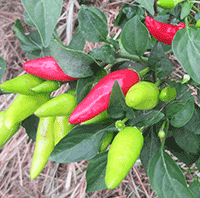 Chilli 'Birdseye Thai'
H
UT
Chilli 'Birdseye Thai'
H
UTCapsicum annuum 'Birdseye Thai' is a must for every keen cook of South East Asian and Indian food. A productive chilli with upright clusters of fruit, approx. 5.5 - 6 cm long, with thin walls and an intense spicy flavour. The fruit start green and ripen to deep red. A good choice to grow in a container as plants are compact. Days to harvest: 85. Very hot: 100,000 to 225,000 Scoville. SC689 (approx. 25 seeds per pkt.) SC716 SC106 |
 Chilli 'Bishops Crown'
H
UT
Chilli 'Bishops Crown'
H
UTCapsicum baccatum Syn. 'Christmas Bell', 'Bishop's Hat' A bushy chilli plant 75 cm high with unusual-shaped fruit. Very hardy, it will grow from the tropics right through to Tassie. It is highly productive and tolerant of poor soils. The fleshy fruit is spicy, crisp and fruity so is a good choice for chilli sauce. Days to harvest: 90 days for green fruit; 100 days for red. Scoville heat scale 5,000 - 30,000 units. SC613 (approx. 35 seeds per pkt.) SC675 SC682 Chilli plants are available seasonally. |
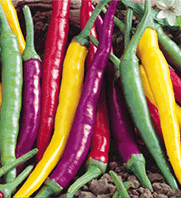 Chilli 'Cayenne Colour Mix'
H
UT
Chilli 'Cayenne Colour Mix'
H
UTCapsicum annuum 'Cayenne Colour Mix' is a medium hot chilli mix that includes red, purple and golden yellow chillies. The long, tapering, slightly curved fruits vary in size from 6 to 12 cm long. The plants are strong, sturdy and highly productive. Use in salsa, pickles, sauces and curries. Fruits can be dried and ground to create chilli powder. Cayenne chillies are productive and hardy, producing over a long period. Days to harvest: 60 - 85 days. Scoville heat scale 30,000 - 50,000 units. SC439 (approx. 20 seeds per pkt.) SC440 |
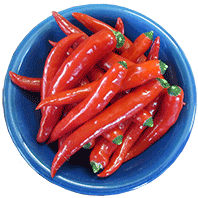 Chilli 'Cayenne Red Hot'
H
UT
Chilli 'Cayenne Red Hot'
H
UTCapsicum annuum Cayenne is a hot and pungent chilli that take its name from a river in Guyana. It has a wide range of uses from drying to use as chilli flakes, steeping in oil or vinegar, seasoning salsa or pickles or dried and strung as 'ristras'. 'Red Hot' chilli fruit are 10 - 12 cm long, ripen to a glossy red and are fairly smooth, less wrinkled than other Cayenne. It is productive and hardy, producing over a long period. It can be long-lived in subtropical and tropical areas. Days to harvest: 60 - 85 days for red. Scoville heat scale 30,000 - 50,000 units. SC676 (approx. 20 seeds per pkt.) SC677 |
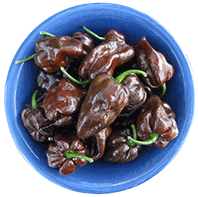 Chilli 'Habanero Chocolate'
H
UT
Chilli 'Habanero Chocolate'
H
UTCapsicum chinense Syn. Black Habanero, Congo Black, Brown Scotch Bonnet 'Habanero Chocolate' is an extremely hot chilli with a unique flavour described as a rich, smoky and fruity. Don't be confused by the attractive chocolate colour and pop one in your mouth, it is more than 75 times hotter than a Jalapeno. It is also spicier and larger than the 'Habanero Red'. Handle it with gloves and start by adding only a few small slivers to your cooking. The fruit are 5 cm long by 2.5 cm wide. The hardy bushes grow to around 1 metre tall and take a while to start producing but continue to fruit over a long period. It can be perennial in subtropical and tropical areas. Days to harvest: 100 days. Very, very hot, Scoville heat scale 450,000 - 500,000 units. SC467 (approx. 15 seeds per pkt.) |
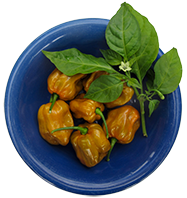 Chilli 'Habanero Golden'
H
UT
Chilli 'Habanero Golden'
H
UTCapsicum chinense Originally from the Caribbean, 'Habanero Golden' is one of the hottest habaneros with a rich, smoky and fruity flavour. The bushes are hardy and productive, growing to a metre tall. The fruit are 5 cm long by 2.5 cm wide, ripening from light green to a beautiful golden orange. Handle it with gloves and start by adding only a few small slivers to your cooking. It can be used in salsa, marinade, chilli sauce or dip. It can be perennial in subtropics and tropics although chillies tend to be hotter when grown in dry, hot areas. Days to harvest: 100 days. Very, very hot, Scoville heat scale 450,000 - 500,000 units. SC130 (approx. 15 seeds per pkt.) |
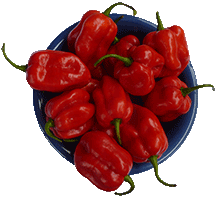 Chilli 'Habanero Red'
H
UT
Chilli 'Habanero Red'
H
UTCapsicum chinense 'Habanero Red' is an extremely hot chilli with a unique flavour described as a rich, smoky-citrus taste. The fruit are 5 cm long by 2.5 cm wide. The productive, hardy, ornamental bushes grow to around 1 metre tall and have a multi-branching, upright growth habit. It can be perennial in subtropical and tropical areas. Habanero chillies have a bonnet shape. Days to harvest: 90 - 100 days for red. Very, very hot, Scoville heat scale 350,000 units. SC641 (approx. 20 seeds per pkt.) |
 Chilli 'Jalapeno'
H
UT
Chilli 'Jalapeno'
H
UTCapsicum annuum 'Jalapeno' chillies taper to a blunt end, are 7.5 cm long and 3 cm in diameter. The fruit are glossy deep green in colour, turning bright red when ripe. The plants are sturdy and productive over a long period and begin cropping early. Plants also grow well in containers. It is a good choice for salsa and dishes where a milder chilli is preferred. Days to harvest: 65 days for green fruit; 85 days for red. Scoville heat scale 5,000 units. SC279 (approx. 20 seeds per pkt.) SC575 SC673 |
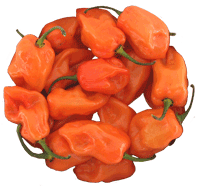 Chilli 'Magnum'
H
UT
Chilli 'Magnum'
H
UTCapsicum chinense 'Magnum' is a high yielding, habanero type chilli with a very spicy, shiny, golden orange fruit. The fruit are 6 cm long by 3 cm wide. The hardy bushes have an upright growth habit and are multi-branching. Habanero chillies have a bonnet shape. Days to harvest: 80 days for green fruit, 100 days for orange. Very, very hot, Scoville heat scale 200,000 - 300,000 units. SC255 (approx. 15 seeds per pkt.) |
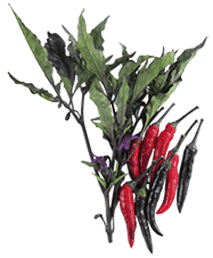 Chilli 'Maui Purple'
H
UT
Chilli 'Maui Purple'
H
UTC. annuum x frutescens Chilli 'Maui Purple' is a highly productive chilli over a long period on compact sturdy bushes to about 50 cm high. Don't be fooled into thinking this is an ornamental chilli because of its good looks as it is definitely a culinary chilli with a very peppery, pungent flavour. The foliage is a deep purple tinged with a green blush and the flowers are purple too. The bushes are covered with shiny dark purple fruit 3 - 4cm long that ripens to red. It can be eaten fresh or dried for chilli powder. In a cool climate it can be grown as a container plant. In its native Hawaii it is grown as a hedgerow around gardens. Days to harvest: 95. Scoville heat scale: above 30,000 units. SC700 (approx. 20 seeds per pkt.) |
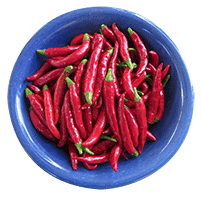 Chilli 'Paprika'
H
UT
Chilli 'Paprika'
H
UTCapsicum annuum 'Paprika' looks a lot like 'Birdseye Thai' but the mild, spicy taste is completely different. It has long, red, narrow fruit to 7 cm long. Use it fresh or it can be dried and ground into powder or strung along string to dry. The hardy bushes grow to around 70 cm tall and take a while to start producing but continue to fruit over a long period. Days to harvest: 100 days. Scoville heat scale 4,000 units. SC554 (approx. 20 seeds per pkt.) SC555 SC385 SC445 |
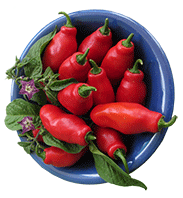 Chilli 'Rocoto Tree'
H
UT
Chilli 'Rocoto Tree'
H
UTCapsicum pubescens Syn. 'Hotlips', 'Locoto', 'Manzano' This is a true heirloom, having been grown for thousands of years by the farmers of Bolivia and Peru. A 'must have' plant for anyone who likes really hot chillies, it grows well from the tropics right through to Tassie (in a suitably sheltered position). It is considered the most cold-tolerant of the chillies. The fruit is produced on a sturdy, wide, bushy, perennial shrub up to 2 - 3 m tall. It has small, dark purple flowers and dark green leaves with a purplish tinge. Highly productive, it crops nearly year round with fruit that start as green turning purple and then glossy bright red when fully ripe, the seeds are black. It is hardy and pest resistant including fruit fly but like all chillies, sensitive to heavy frost. Fruit ranges from medium hot to extremely hot depending on the weather. The fruit is fleshy like a capsicum so is a good choice for chilli sauce. Days to harvest: 95 days for green fruit; 130 days for red. Scoville heat scale 100,000 - 300,000 units. SC514 (approx. 15 seeds per pkt.) SC531 SC383 Chilli plants are available seasonally. Grower needed... |
 Chilli 'Serrano'
H
UT
Chilli 'Serrano'
H
UTCapsicum annuum 'Serrano' is similar in shape to a 'Jalapeno' but slightly smaller and hotter. It is a favourite for Mexican dishes such as salsas, pickles and sauces. The glossy green fruit have a thick wall and soft, sweet flesh. Growing 6 cm long on productive 2 m high bushes, the fruit turns orange-red at maturity. The word 'Serrano' derives in Spanish as coming 'from the mountains'. Days to harvest: 80. Scoville heat scale 10,000 - 20,000 units. SC434 (approx. 25 seeds per pkt.) SC435 SC436 |
|
Collards
Syn. borecole, tree-cabbage, non-heading cabbage.
H
Brassica oleracea Acephala Group Collards are a cool season annual with large, succulent, ruffled, deep blue-green leaves that form a loose rosette like an open cabbage; no head is formed. It is easy to grow and hardy. Collards are both heat and cold tolerant, frost resistant and slow to bolt. Collards are easier to grow in warmer areas than cabbages. Like all brassica, the flavour is considered to be improved by frost. Grow it during the cool season to use as a nutritious, steamed, tender green with a delicious, mild cabbage flavour. In temperate areas sow early spring and early autumn; in subtropical and tropical areas sow March - July. Collards germinate best between 13 - 23°C soil temperature. Sow seed 6 mm deep in seedling trays or garden bed. Seeds take 7 - 10 days to germinate. Transplant seedlings by first carefully removing the seed leaves and planting deeper, up to the first set of true leaves. Doing this speeds maturity and makes the plant more resistant to wind damage. Space the plants 25 - 30 cm apart, with 60 - 90 cm between rows. Collards like a rich, well-drained soil with a pH 6.5. Prepare the soil by digging well-rotted compost or animal manure through the bed. Keep the soil moist; add organic fertiliser when plants are half grown. Covering young seedlings with a cover such as Vege Net will protect them from White Cabbage butterflies. |
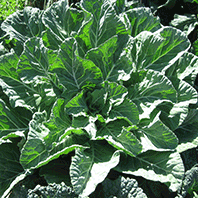 Collards 'Georgia Southern'
H
UT
Collards 'Georgia Southern'
H
UT'Georgia Southern' is a heirloom vegetable released in 1880. Days to harvest: 60 - 75, pull leaves from the bottom of the plant. SC526 (approx. 100 seeds per pkt.) SC527 SC569 SC579 |
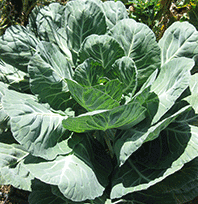 Collards 'Vates'
H
UT
Collards 'Vates'
H
UTSyn. Blue Stem, Vates Non-Heading 'Vates' has smooth, slightly crumpled leaves on vigorous spreading plants. The dark green leaves with pale green veins are crisp and delicious. It is a multi-purpose green eaten both raw and cooked. Collards are both heat and cold tolerant, frost resistant and slow to bolt. Collards are easier to grow in warmer areas than cabbages. Days to harvest: 75, harvest by pulling leaves from the bottom of the plant. SC443 (approx. 100 seeds per pkt.) SC444 SC452 |
Cucumber
Cucumis sativus Sow cucumbers direct into the soil after all danger of frost has past; in tropical areas sow during the dry season. Cucumbers are suitable for temperate, subtropical and tropical areas. Sow 1 - 2 cm deep and 50 cm apart if on a trellis, 1 metre apart if planted into raised mounds. Growing on a trellis reduces fungal problems, it is also helpful to spray regularly with seaweed. Prepare the soil with compost and well-rotted manure; cucumbers dislike acidity and need frequent watering. Pinch out the terminal bud to encourage branching, as side branches are more fruitful. Harvest cucumbers daily with 2 cm of stem to reduce water loss and improve storage of the fruit. Information for growers regarding cucumber pollination requirements. |
 Caigua
H
UT
Caigua
H
UTCyclanthera pedata Syn. Bolivian cucumber, achocha, korila. Caigua (pronounced kai-wa) is an ancient crop from the Andes. The young fruits are eaten raw in salads or pickled, the flavour is similar to cucumber. The older hollow fruits can be cooked in stir-fries or stuffed after removing the hard, black seeds. The young shoots and leaves may also be eaten as greens. The vines fruit prolifically and need a good-sized trellis. It is easy-to-grow, hardy and disease resistant. It is the same species but a much smaller form than Cucumber 'Giant Bolivian'. Days to harvest: 100 days. SC470 (approx. 15 seeds per pkt.) SC139 |
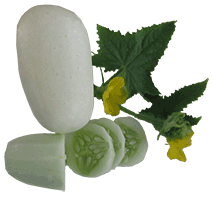 Cucumber 'Boothby's Blonde'
H
UT
Cucumber 'Boothby's Blonde'
H
UTA USA heirloom that is highly productive and has been recognised by the Slow Food Ark of Taste as in need of preservation. The cucumbers are oval, with a creamy-white skin ripening to golden with an excellent crisp, sweet flavour with no need to peel. It is best eaten at 10 cm long. It copes well with hot, humid weather and appears resistant to powdery mildew. Days to harvest: 63. SC146 (approx. 20 seeds per pkt.) Grower needed... |
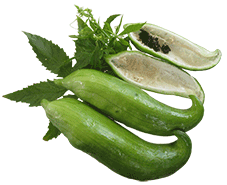
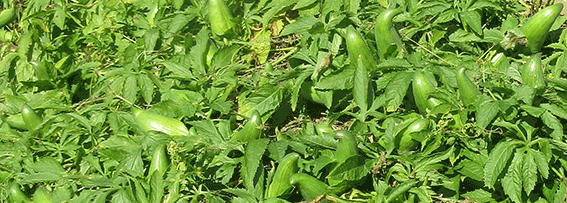 Cucumber 'Giant Bolivian'
H
UT
Cucumber 'Giant Bolivian'
H
UTCyclanthera pedata Syn. Achocha, Stuffing cucumber, Slipper gourd. Giant Bolivian Cucumber is an ancient crop from the Andes, it is a close relative of Caigua but much larger, growing 15 - 18 cm long. The young fruits are eaten raw in salads or pickled with a similar flavour to cucumber. The older hollow fruits can be cooked in stir-fries or stuffed after removing the hard, black seeds. Stuffed they have a flavour similar to capsicum. The young shoots and leaves may also be eaten as greens. The vines fruit prolifically and need a good-sized trellis. It is easy-to-grow, hardy and disease resistant. Days to harvest: 100 days. SC702 (approx. 10 seeds per pkt.) |
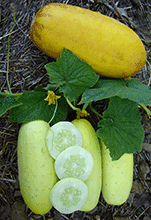 Cucumber 'Giant Russian'
H
UT
Cucumber 'Giant Russian'
H
UTsyn. 'Gympie Gold' This is an excellent variety for humid areas, although of course, it will grow anywhere a cucumber does. The vines are vigorous and best treated as a climber. The fruits are very large, crisp, sweet and acid-free and change to golden as they ripen. It has the advantage of keeping for several months. Hardy and much more resistant to mildew than Lebanese cucumbers. SC373 (approx. 20 seeds per pkt.) SC719 |
 Cucumber 'Long White'
H
UT
Cucumber 'Long White'
H
UTSyn. Redlands Long White Introduced by the Redlands Horticultural Station in South-East Queensland in 1985, 'Long White' is a vigorous, reliable, heavy-yielding variety. The straight, white, thin-skinned fruit grows to 18 cm long. It has a tangy cucumber flavour and is considered low acid, inside the flesh is white and crisp. It can be used in salads, sandwiches or pickled. It continues to produce over a long period and copes well with hot weather. It is resistant to powdery mildew and does best growing on a trellis. Days to harvest: 63 - 70. SC358 (approx. 20 seeds per pkt.) SC731 |
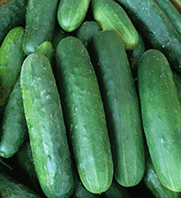 Cucumber 'Poinsett'
H
UT
Cucumber 'Poinsett'
H
UT'Poinsett' is a reliable, disease resistant, heavy yielding variety of cucumber. It has straight, dark green fruit growing 17 - 20 cm long; inside the flesh is white and crisp and full of flavour. It continues to produce over a long period and copes well with hot weather. It does best growing on a trellis. Days to harvest: 65. SC545 (approx. 30 seeds per pkt.) SC581 |
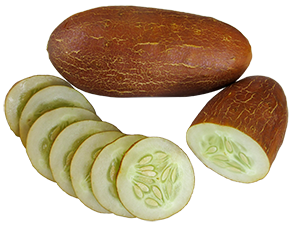 Cucumber 'Poona Kheera'
H
UT
Cucumber 'Poona Kheera'
H
UTOriginally from India, this very unusual cucumber changes colour from white to golden-yellow and then to russet brown. At all stages the white flesh is crisp, tangy and juicy. It is very hardy and disease resistant continuing to produce over a long period. It copes extremely well with hot weather. It is early producing making it great for cool climates. Days to harvest: 55. SC207 (approx. 20 seeds per pkt.) SC208 |
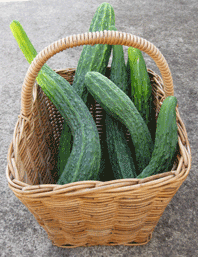 Cucumber 'Suyo Long'
H
UT
Cucumber 'Suyo Long'
H
UT'Suyo Long' is a traditional long-fruited variety from China. It has a mild-flavoured, ribbed fruit growing up to 35 cm long and is considered a 'burpless' type. It copes well with hot weather. Growing on a trellis produces straight fruits and reduces fungal problems, this variety continued to produce through recent flooding rains with virtually no mildew. Days to harvest: 51. SC333 (approx. 20 seeds per pkt.) Grower needed... |
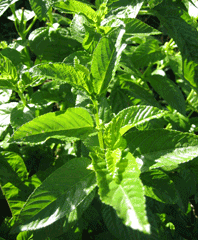 Egyptian Spinach
H
UT
Egyptian Spinach
H
UTCorchorus olitorius syn. Molokhia, Malu Khia, Melokheya, Meloukia, Salad Mallow, Jew's mallow, West African sorrel A very hardy, fast growing annual to 1m. The young leaves used in salad, older leaves and the shoot tips cooked as spinach and are high in protein. It self-sows readily. Sow spring and summer. Suitable for subtropical and tropical areas. SE113 (approx. 100 seeds per pkt.) Egyptian Spinach plants are available seasonally. |
|
Are you looking for
Zaatar seed?
|
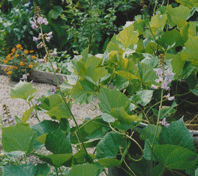
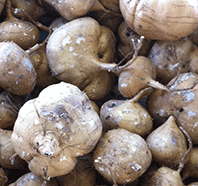 Jicama - Climbing Yam Bean
H
UT
Jicama - Climbing Yam Bean
H
UTPachyrrhizus erosus Climbing plant from Central America, with delicious sweet, crisp tuber, eaten raw or cooked, flowers are removed, as seeds are toxic. Sow spring in the subtropics; sow all year in the tropics; in warm temperate areas do not sow before early summer as it requires a very warm soil to germinate. Suitable for temperate, subtropical and tropical areas. Jicama growing information... SJ101 (approx. 15 seeds per pkt.) SJ106 SJ104 |
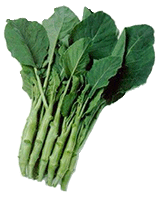 Kailaan
H
UT
Kailaan
H
UTBrassica oleracea Alboglabra Group syn. Chinese Broccoli; Chinese kale; gai lum, gai lan (China); kol (Indonesia); kai lan (Malaysia); phak khana (Thai); cai ro (Vietnam) A fast growing, hardy vegetable that can be planted close together, making it very productive for small spaces. It is harvested for its thick, succulent stems, leaves and flower buds, which are delicious cooked. Very nutritious, a good source of Vitamin C and antioxidants. It is heat and frost tolerant. Kailaan fills the gap waiting for the broccoli crop to start producing. It germinates best between 18 - 24°C soil temperature. In cool areas sow October - February; in temperate areas sow spring to autumn; in subtropical areas sow March - September; in tropical areas sow April - August. Days to harvest: 60-70. SK170 (approx. 100 seeds per pkt.) SK171 |
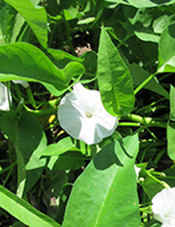
 Kangkong
H
UT
Kangkong
H
UTIpomoea aquatica syn. Water Spinach Ground-hugging, Thai vegetable that likes moist soil; young leaves, stems and tips are delicious cooked in a stir-fry or steamed. Sow spring and summer. Suitable for subtropical and tropical areas. SK119 (approx. 30 seeds per pkt.) SK137 SK154 Kangkong plants are available from November to January. |
 'Madagascar' Bean
H
UT
'Madagascar' Bean
H
UTPhaseolus lunatus Syn. Lima del Papa Runner, Christmas Lima A vigorous, climbing, tropical lima bean, it lives for many years and is excellent at coping with wet, humid conditions. It can be used as a tropical alternative to broad beans or as a dried bean. The dried beans cook quickly and make tasty vegetarian burgers! Suitable for warm temperate, subtropical and tropical areas. Madagascar Bean growing information. SB111 (approx. 10 seeds per pkt.) SB371 |
 Mibuna
H
UT
Mibuna
H
UTBrassica rapa var. nipposinica Syn. Mibu greens. Very similar to mizuna but with smooth edged leaves. In warmer areas it is best planted in the winter, avoiding the peak caterpillar season of Feb-March. In cool areas plant from spring to autumn. Mibuna is a salad green from Japan, use while young; older leaves can be steamed as a spinach or eaten in soups and stir-fries. SM221 (approx. 150 seeds per pkt.) SM222 |
 Moringa
H
UT
Moringa
H
UTMoringa oleifera Syn. Horseradish Tree, Drumstick Tree, Ben Tree, Miracle Tree Moringa is a semi-deciduous tree to 8 m high and 3 m wide. It is a hardy, shrubby tree with fern-like leaves and white, fragrant flowers. The pungent roots are used as a substitute for horseradish; the young leaves are eaten as cooked greens and the immature pods have an artichoke flavour and are eaten in a similar way. The leaves are very nutritious, high in vitamins and with up to 38% protein. The flowers are attractive to bees. The seeds are used for water purification. The seeds germinate best between 25 to 30°C soil temperature, sow late spring in subtropical areas. It will grow in sun to partial shade but needs a well-drained soil. It is suitable for subtropical and tropical areas; unsuitable for temperate areas. More growing information... SM215 (approx. 15 seeds per pkt.) Are you looking for Moringa plants? |
 Mung Bean
H
OG
Mung Bean
H
OG
Vigna radiata Quick growing and hardy, adds nitrogen, builds organic matter; combine with buckwheat or Japanese millet; produces edible seeds. Sow in temperate areas November - February; in subtropical areas September - March and tropical areas during the wet season. SM130 I SM1312.5kg I No TAS SM1922.5kg I No TAS SM16710kg I No TAS SM18710kg I No TAS Are you looking for Organic Mung Bean seed for sprouting? |
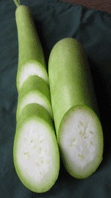
 New Guinea Bean
H
UT
New Guinea Bean
H
UTLagenaria siceraria Syn. Italian edible gourd, gourd cucuzzi, Indian squash, bottle gourd, calabash gourd, doodhi, lowki Not of course a bean at all, instead this is a type of squash. A traditional Italian vegetable, the light green fruits are cylindrical 60 - 100 cm long and can weigh up to 2.5 kg. The creamy white flesh is said to have a flavour and texture similar to green beans, which is probably where it gets its common name. The white flowers are large and scented. Sow next to a trellis, after all danger of frost has passed, with a minimum soil temperature of 22°C, 2.5 cm deep, 30 cm apart. Early plants can be sown in seedling pots for later transplanting. Prepare well-drained soil with compost and well-rotted manure. Pick the green fruit when young, 15-60 cm long. Prepare it in a similar way to squash. SN101 (approx. 10 seeds per pkt.) SN107 Looking for Guada Bean? There is a bit of confusion around this plant name. It is sometimes used as a synonym for New Guinea Bean Lagenaria siceraria which is a true gourd but more often refers to Serpent Gourd Trichosanthes anguina. |
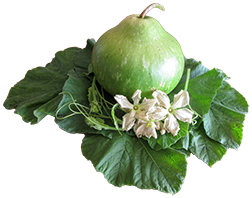 New Guinea Bean 'Kobu'
Rare
H
UT
New Guinea Bean 'Kobu'
Rare
H
UTLagenaria siceraria Syn. lauki, Indian squash, bottle gourd, calabash gourd, doodhi, lowki This is a round version of the more common New Guinea Bean with a similar range of uses. It has a mild taste and is mainly used as an ingredient in spicy dishes to soak up the flavour. The creamy white flesh is said to have a flavour and texture similar to green beans, which is probably where it gets its common name. The white flowers are large and scented. The vines are vigorous and quickly cover a large trellis. It is useful in the subtropics and tropics as an alternative to zucchini, which is very prone to powdery mildew in humid areas. Sow next to a trellis, after all danger of frost has passed, with a minimum soil temperature of 22°C, 2.5 cm deep, 30 cm apart. Early plants can be sown in seedling pots for later transplanting. Prepare well-drained soil with compost and well-rotted manure. Pick the green fruit when young, prepare it in a similar way to squash. SN113 (approx. 10 seeds per pkt.) SN111 |
|
Welsh or Bunching Onion
H
Allium fistulosum Also known as Welsh onion; Japanese bunching onion; evergreen bunching onion; taai tsung, qing cong, xiao cong (China); bawang daun (Indonesia); atasuki, negi (Japan); bawang daun (Malaysia); ton horm (Thai); hanh (Vietnam). Welsh onions are a hardy, non-bulbing, often perennial, spring onion with a mild, sweet flavour. It has tube-like, hollow, green leaves above white stems; the white shaft plus a few cm of the green leaves are eaten. It is a versatile plant, extremely hardy and pest resistant, that will generally grow from cold regions right through to hot, tropical areas. The seeds can also be sprouted. Older varieties will form a clump; some modern cultivars are best grown as annuals and will fail to clump up very much at all. Welsh onions prefer an open, sunny site, with free drainage and a pH above 6.5. The flowers of Welsh onions are attractive to bees and other useful insects. Sow seed in autumn or spring; it germinates best at 10 - 24°C soil temperature; in warmer areas try germinating the seed tray in the bottom of the fridge to get it started. Sow seed into a seedling tray, 5mm deep, cover with soil and firm down. Transplant the seedlings once large enough to handle. Space rows 30 - 70 cm apart with 15 - 30 cm between plants. Seed takes 7 - 21 days to germinate. Established clumps can be divided to for propagation material. |
 Onion 'Ishikura Winter Long'
H
UT
Onion 'Ishikura Winter Long'
H
UTAllium fistulosum 'Ishikura' is a popular variety in Japan for its long, white stems and excellent flavour. It has a very long 45 cm of white stalk; 75 cm overall in length. It is a vigorous, non-bulbing spring onion with tube-like, hollow, blue-green leaves. Use it in salads, stir-fries and soups. It will grow from cold regions right through to subtropical areas. It is hardy, frost tolerant and pest resistant. 'Ishikura' is best grown as an annual and is unlikely to form a clump. Sow seed in autumn or spring; it germinates best at 10 - 24°C soil temperature. 66 days to begin harvest. This is an F1 hybrid so is not suitable for seed saving. SO154 (approx. 200 seeds per pkt.) SO155 SO156 |
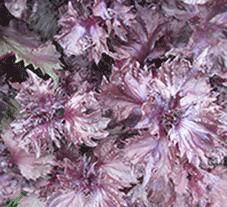 Perilla 'Red Shiso'
H
UT
Perilla 'Red Shiso'
H
UTPerilla frutescens crispa Syn. Beefsteakplant, Summer Coleus This Japanese culinary herb is a very aromatic plant, with a flavour between mint and basil. It is a great addition to salads and a very ornamental garnish. The leaves are popular in Japan for flavouring raw fish, bean curd, pickles and tempura. It is also used to give a scarlet colour to pickled plums and preserved ginger. The plants prefer a sunny open position in moist, fertile, well-drained soil. The seeds germinate at 20 - 22°C; germination is slow and can take up to 30 days. Sow spring to early summer in temperate areas; spring to summer in subtropical areas; during the dry season in tropical areas. Days to bloom: 80 - 85 days. SP172 (approx. 50 seeds per pkt.) |
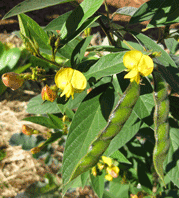
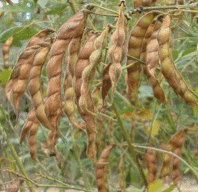 Pigeon Pea
H
UT
Pigeon Pea
H
UTCajanus cajan Pigeon Pea is an excellent chicken forage for warmer areas, providing high protein seeds, edible leafy greens and shelter. It is a perennial, nitrogen-fixing, drought tolerant shrub to 2 - 3 m. It is also useful for on-site mulch production and is an excellent animal forage. It is an important food plant in India; the seeds are 25% protein and can be eaten fresh or as split dried peas. The dried seeds are used for dhal in India and contain 5 times more Vitamin A and C than green peas. The leaves and young shoots can be eaten cooked, they are fibrous and have a strong spicy odour. Sow spring and summer into warm soil; autumn in frost-free areas only. Suitable for (warm) temperate, subtropical and tropical areas. More information on pigeon pea... SP123 (approx. 60 seeds per pkt.) I SP351 (approx. 125+ seeds per pkt.) I SP124 (approx. 500+ seeds per pkt.) I SP339 (approx. 1250+ seeds per pkt.) I SP244 (approx. 5000+ seeds per pkt.) I |
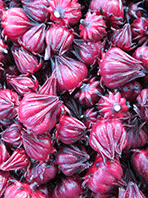 Rosella
H
UT
Rosella
H
UTHibiscus sabdariffa syn. Queensland jam plant, Jamaican tea, karkade Rosella is an annual shrub to 2m with attractive yellow hibiscus-like flowers. The plants are vigorous and easy to grow. The calyx (fleshy cover surrounding the seed pod) is used to make jam, cordial and wine. Dried the red calyx can be used for herb tea and is high in vitamin C. To prepare it, strip off the red calyx from the seedpod and dry it in a food drier or a slow oven until crisp. Seeds can be roasted and ground into flour. Young leaves can be steamed and are known as Red Sorrel in the Pacific. Sow seed in early spring, as it needs a long growing season and takes at least 5 months frost-free to fruit. Bottom heat will be required to get the seed germinated in cooler areas. Suitable for warm temperate, subtropical and tropical areas. See here for jam and cordial recipe and growing information. SR248 (approx. 15 seeds per pkt.) SR249 SR250 SR119 SR158 |
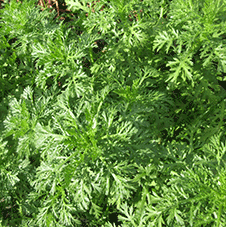 Shungiku
H
UT
Shungiku
H
UTChrysanthemum coronarium syn. Garland Chrysanthemum An aromatic annual, green, leafy vegetable to use in salads, stir-fries and sushi. Small, orange and yellow daisy flowers appear towards the end of the season on unharvested plants that can grow to 1m. It is best harvested at 10-20 cm tall. It will grow in full sun or semi shade in a rich well-drained soil with added compost. Sow autumn and early spring in temperate areas. Sow in winter in subtropical and tropical areas. Avoid sowing during summer as plants will bolt rapidly and become bitter. Harvest in 21 days (baby leaf) to 45 days. SS161 (approx. 100 seeds per pkt.) SS188 SS314 |
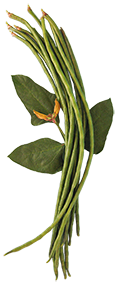 Snake Bean Climbing 'Red Dragon'
H
UT
Snake Bean Climbing 'Red Dragon'
H
UTVigna unguiculata var. sesquipedalis syn. Chinese Long Beans, Yard Long Bean, Asparagus Bean 'Red Dragon' produces 60 - 70cm long, dark green slender pods with a small red-brown tip; seed is red coloured. Highly productive and can be picked for approx. 4 weeks. Snake beans are very nutritious and have a slightly sweet flavour and crunchy texture; use them steamed, in stir-fries or curries. Snake bean is resistant to Bean Fly and Rust that can make French or runner beans difficult to grow over summer. Sow all year round in tropical and frost-free areas. Elsewhere sow from spring to early summer. SB296 (approx. 20 seeds per pkt.) |
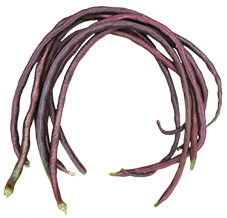 Snake Bean Climbing 'Red Noodle'
H
UT
Snake Bean Climbing 'Red Noodle'
H
UTVigna unguiculata var. sesquipedalis syn. Chinese Long Beans, Yard Long Bean, Asparagus Bean 'Red Noodle' produces 30 cm long, attractive dark red slender pods; seed is a reddish brown colour. Highly productive and can be picked for approximately 4 weeks. Snake beans are very nutritious and have a slightly sweet flavour and crunchy texture; use them steamed, in stir-fries or curries. Snake bean is resistant to Bean Fly and Rust that can make French or runner beans difficult to grow over summer. Sow all year round in tropical and frost-free areas. Elsewhere sow from spring to early summer. SB402 (approx. 20 seeds per pkt.) |
 Squash 'Chilacayote'
H
Squash 'Chilacayote'
H
 UT
UTCucurbita ficifolia Syn. fig-leaf gourd, malabar gourd, Siam pumpkin, Thai marrow, shark fin melon, chiverre, pie melon, calabaza china, cayote, gila, potiron cheveux d'ange, calabaza de cabello de angel, alcayota, seven year melon, Malabar gourd, chiverre. Chilacayote is widely grown as a vegetable in Mexico and South America. It grows like a pumpkin vine to 15m long and forms roots in the leaf nodes. The melon-like fruit are large, round, green and white speckled. Highly productive vines produce fruit that can weigh up to 6kg. The flowers, leaves and tender shoots are used as greens. Young fruit are eaten cooked, mature fruit are used in jams and confectionery. The protein-rich seeds are very nutritious. Vines are very hardy and disease resistant. The fruit stores for many months. This is a completely different plant to Jam Melon Citrullus lanatus syn. Red Seeded Citron, an ancestor of the watermelon. SC455 (approx. 10 seeds per pkt.) SC566 SC720 SC141 |
|
Sweet Potato
H
No Norfolk Island, TAS or WA Ipomea batatas Sweet potatoes are vining plants with attractive lobed leaves, pink morning-glory type flowers and tuberous roots. They are a 'must have' vegetable in warmer climates as they are so easily grown, highly nutritious and can be used in wide range of recipes. The vines are vigorous so space is needed. They do best in areas that are frost-free for at least 5 months with warm days and nights. In cooler areas wait for the beginning of the warm weather to plant. In subtropical and tropical areas sweet potato can be planted all year round. Sweet Potato growing information... Sweet potato plants are available seasonally. |
 Timor Lettuce
H
UT
Timor Lettuce
H
UTNo WA Lactuca indica syn. Indian Lettuce Indian Lettuce is a close relative of lettuce but grows faster, taller and is hardier to hot temperatures and high humidity. It will grow across a wide climate range from cooler areas to the tropics. It is a fast-growing, upright leafy green that can grow as high as 2 m. It has a semi-perennial habit and can be cut back after flowering to re-shoot. It will grow in full sun, but plants grown in partial shade will produce larger, more tender leaves. Very young, tender leaves are eaten raw in salads, older leaves can be cooked like spinach. The leaves have a somewhat bitter flavour, closer to chicory than lettuce. It is also used in traditional medicine. It self-sows readily and care should be taken to avoid weediness. A useful plant for poultry forage systems. In temperate areas sow late spring; in subtropical and tropical areas sow all year. Seed germinate best between 20 - 26°C soil temperature. Seed takes 4 - 10 days to germinate. ST240 (approx. 100 seeds per pkt.) No WA |
 Tomatoes can suffer a range of pest and disease problems in the tropics. Try these hardy types for a good chance
of success. Sow seed in the dry season and practice crop rotation.
Tomatoes can suffer a range of pest and disease problems in the tropics. Try these hardy types for a good chance
of success. Sow seed in the dry season and practice crop rotation.Cherry Red Pear Cherry Yellow Pear Tomato 'Tropic' Tomato 'Thai Pink Egg' |
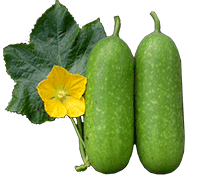 Wax Gourd
H
UT
Wax Gourd
H
UTBenincasa hispida syn. Chinese winter melon, flour gourd A fast growing, long season, warm climate vegetable producing very large fruit up to 20 kg but it is best harvested at 2 kg. The gourds are green with a white waxy coating. The wax gourd keeps for many months off the vine and is eaten raw or cooked. The shoots, tendrils and leaves are also eaten as greens; seeds are edible and are tasty roasted. Use the white flesh of this giant fruit in a chicken and wax-gourd curry; serve appetizers of finely chopped stir-fried vegetables in bowls made from a hollowed-out melon. Sow after frost in spring; in tropical areas sow during the dry season. Sow direct into well composted soil, 1-2 cm deep, 1 m apart on raised mounds, rows 1 m apart. Days to harvest: 100. SW121 (approx. 45 seeds per pkt.) SW171 |
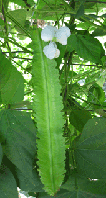
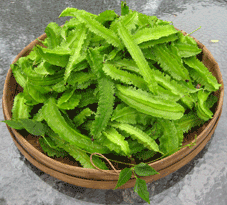 Bean 'Winged'
H
Bean 'Winged'
H
 UT
UTPsophocarpus tetragonolobus syn. Goa Bean, Asparagus pea Winged bean is a vigorous, tropical climber with mauve-blue flowers and four-angled pods with wavy margins. The pods, leaves, flowers and tubers are all edible. It is high in protein: the seeds contain 34% protein and 17% oil; the root contains 20% protein. If you are growing it for pods, leaves or flowers, grow it on a trellis; a trellis is not needed if you are growing it for the tuberous roots - let it sprawl. Of course, you will need to replant annually if you are harvesting the roots. The young leaves (top three sets of leaflets on a shoot) are cooked and eaten. The flowers taste like sweetish mushrooms. It is among the world's most effective nitrogen-fixers. A short day length (11-13 hours of daylight) during hot weather is required to flower, so it is not suitable for temperate areas; it is also very frost sensitive. It grows to 3 - 4m. Wait for warm, humid weather before sowing; in the subtropics sow November - December; in the tropics sow October until January. It will grow on a wide range of soils but requires moisture to do well; it tolerates acidity. Plant rows 1m apart; with 30 - 60 cm between plants. To improve germination either rub seeds with sandpaper or soak in hot water until the seeds swell. Harvest the pods when 10 - 20 cm long; use like green beans. Days to harvest: 60. SB113 (approx. 15 seeds per pkt.) SB214 SB244 Find other bean varieties here. |
|
Green Harvest specialises in seeds which are:
|
A
free
Successful Seed Raising Guide is included with your first seed order from Green Harvest.
Seed to WA:
A $6.95 Quarantine Fee will be charged for all seed orders to WA. Green Harvest is sharing the cost of
the quarantine fee with all our WA customers.
Read more...
 Home
Home
Green Harvest Organic Gardening Supplies is permanently closed as of 5pm on 1-11-2023.
We will not be taking orders by this website, in person, by phone or email. Our display garden and retail shop are closed forever.
Read more...
Phone:07 54357000
Phone calls will only be responded to sporadically and only in reference to orders placed prior to 2-11-2023. All the useful growing and organic pest management research and resources are available on this website for a while still.
We guarantee our seeds to the value of the purchase price. We are happy to replace the seeds, give you a credit or refund, whichever you prefer. Other than our guarantee to the extent of the purchase price Green Harvest gives no other warranty expressed or implied. No liability will be accepted by Green Harvest, its owners or employees as to the accuracy of any information. No responsibility will be taken for damage to property or persons due to information given about a product or technique. No responsibility will be taken for the loss of a crop or income due to information given about a product or technique.
 Shopping here is private and secure.
Shopping here is private and secure.
Copyright © 2001 - 2024 Green Harvest Organic Gardening Supplies
No part of this website may be reproduced without permission of the owner
